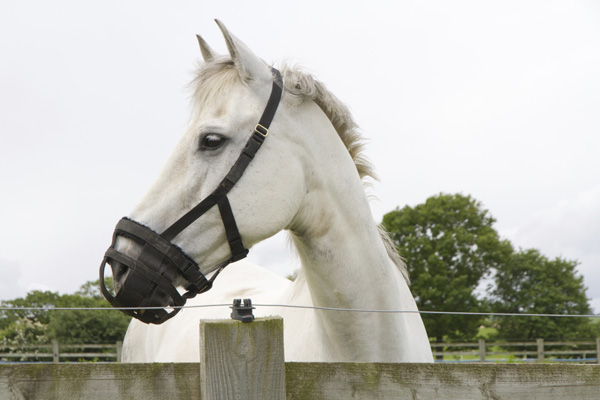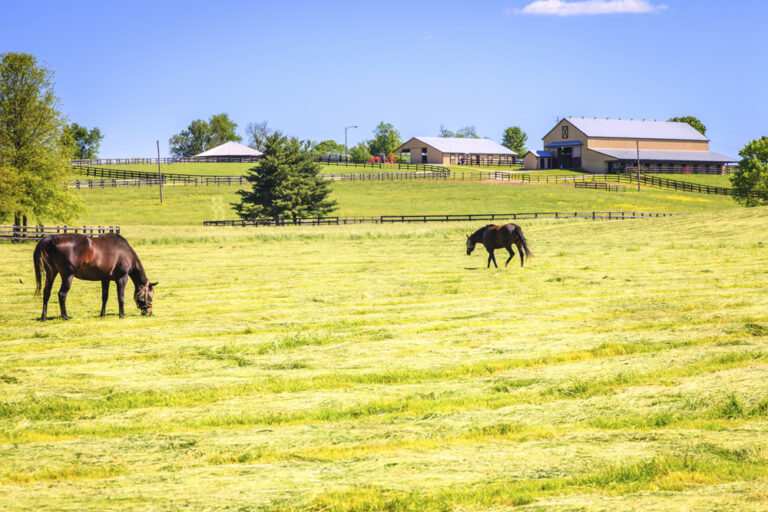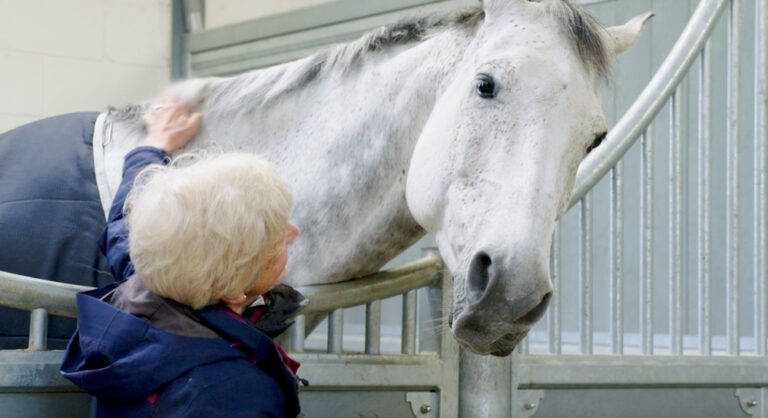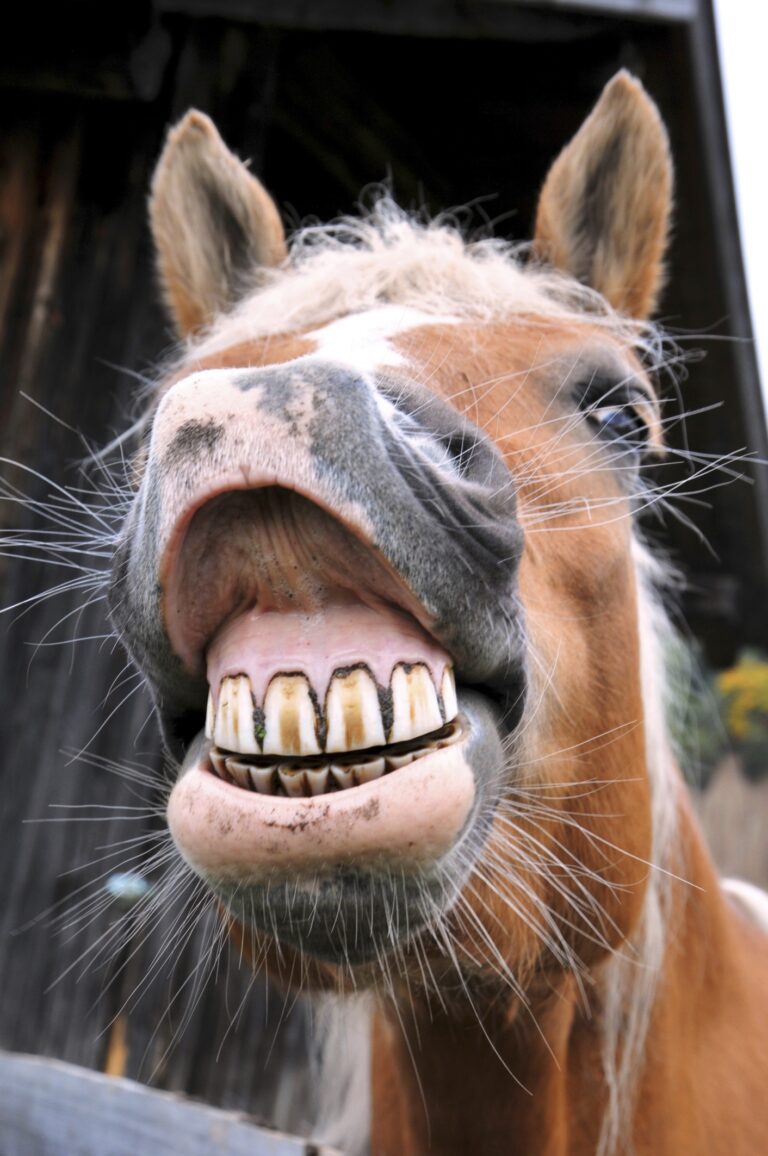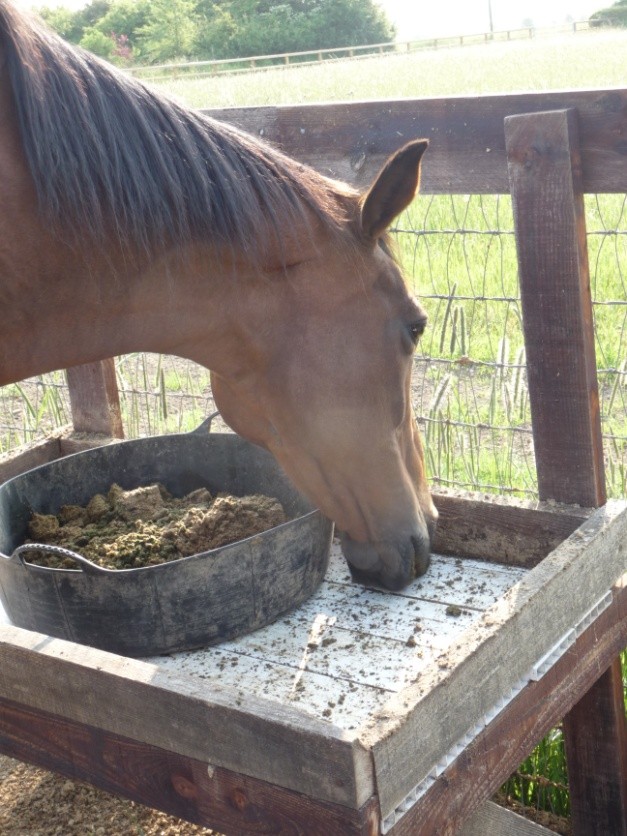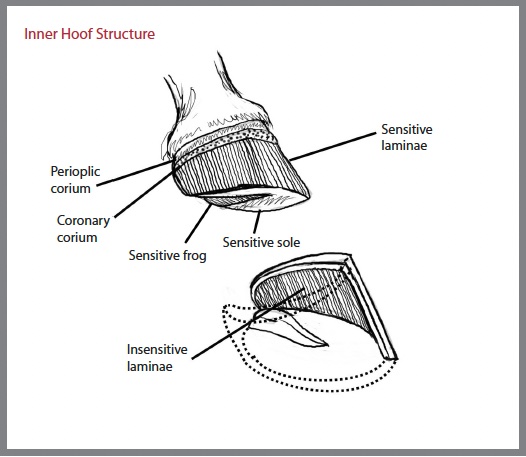Grazing muzzles are tools that can be useful with equids that are overweight. They also can help manage some issues that require animals to have restricted intake of fresh forage.
The number of obese horses and ponies used for leisure and pleasure purposes around the world is growing. It is estimated that more than 50% could be classed as overweight or obese.
Keeping horses and ponies out at pasture with each other can be very beneficial in many ways. However, the intake of grass can contribute to obesity. It also can increase their risk of developing certain clinical conditions such as pasture-induced laminitis and insulin dysregulation.
Therefore, it is often necessary to restrict the intake of grass for many horses and ponies.
In this article, we’ll talk about grazing muzzles and offer you some tips on best use.
Grazing Muzzles for Horses
Individuals on restricted diets can adapt their grazing behaviour to eat more in a shorter period of time. For instance, in just 3 hours at pasture, ponies needing restricted diets can eat up to two-thirds of their recommended daily intake!
Therefore, restricting ponies’ diets by reducing turnout time might be less effective than using a grazing muzzle.
A grazing muzzle, when used effectively and appropriately, can be a very useful tool. It allows you to manage your animal’s weight whilst still allowing them to have time out grazing.
Muzzles should be used carefully. The following are some tips (not exhaustive) to help you do this.
Grazing Muzzles Must Allow Some Access
The purpose of most grazing muzzles is to limit—but not totally restrict—pasture intake. Take note of the following tips.
- Horses should have constant access to water.
- Total restriction muzzles (that prevent access to grass and water) are very unlikely to be suitable for most horses. They should only be utilized under specific, very short-term circumstances or as recommended by your veterinarian.
- Grass needs to be accessed through the base of the muzzle. If, for example, the grass is too short or too long, then it might be impossible or extremely difficult for the horse or pony to access the grass. This could result in abnormal or ‘stressed’ behavior.
One Size/Type Does Not Fit All
There are different types of grazing muzzles for a reason. Individual animals will suit different styles of grazing muzzles. The key is finding the one that works with your horse, pony, donkey, or mule.
Muzzle Fit
If you need to use a grazing muzzle, don’t just borrow something from a friend or neighbor that almost fits. (Author’s note: See the National Equine Welfare Council Grazing muzzle guidance.)
Follow these guidelines for fitting.
- Fit a muzzle to your animal according to the manufacturer’s guidelines. (This can sometimes be quite confusing. Asking for help from someone who has already used that type of muzzle can be very helpful.)
- Muzzles should ‘break away’ if the horse gets into difficulties.
- Do not fit muzzles too tightly.
- Remember that even if your horse keeps getting its muzzle off, you do not want to attach it so firmly that it could not break away if it gets caught. Try a different style of muzzle and/or check that the grazing is suitable for muzzle use.
- For ‘close fitting’ muzzles with a central access hole, the muzzle should be positioned such that there is at least about 1-inch (25-mm) gap between the base of the muzzle and the horse’s nose. This enables the muzzle hole to be positioned below the incisors. There needs also to be a gap (about 0.5 inches or 12 mm) around the edge of the muzzle to allow movement of the jaw.
- Watch the horse grazing with the muzzle and adjust as required.
Allow for Adaptation
Grazing muzzles require an adaptation period. Therefore, do not leave horses/ponies for long periods of time when first fitted with a muzzle.
- You can encourage horses to use the hole/slats to graze. Try introducing cut blades of grass through the hole or providing a treat (mint/carrot) in a similar way.
- Don’t leave horses/ponies unsupervised while wearing muzzles until they have been observed to graze and drink.
Ensure the Environment is Suitable for a Muzzled Animal
You need to observe and inspect the environment into which you will be releasing the muzzled horse. Look for the following.
- Check that the fencing and gates are suitable for use by animals with a grazing muzzle. You don’t want them to get caught.
- All feed and water vessels that might be used by horses wearing muzzles need to be smooth to minimize the risk of the muzzle getting snagged
Check Muzzled Animals Regularly
Using a grazing muzzle—especially at first—is not a ‘put it on and leave it’ scenario. You must be a good observer and manager of these muzzled animals.
- Muzzles need to be checked regularly to ensure they are not causing any rubbing injury to the muzzle, cheekbones, etc.
- Also check for any wear and tear that might affect your horse’s health.
- The use of grazing muzzles can disturb herd social dynamics. Check that they are not being bullied and are not being prevented from accessing water. This sometimes necessitates the separation of horses in the group.
- Ensure that the animal’s teeth are checked regularly, typically every six months, as the use of muzzles might cause teeth to wear unevenly.
- Just because the use of grazing muzzles might reduce the amount of grass an individual can eat by up to 80%, it is still important to monitor them regularly for changes in their body weight and condition.
- Monitor your horse/pony’s behaviour regularly for signs of stress or frustration.
Important Things to Consider
Again, this is not a ‘strap it on and leave’ sort of scenario. Make sure to give the animals breaks from grazing muzzles.
- All animals should have regular periods of time without a muzzle to enable them to groom themselves, and so on.
- If grazing muzzles are removed and animals are left to freely graze, there can be compensatory intake. This might increase the risk of obesity and laminitis. Consider stabling or non-grass turnout (with controlled amounts of an alternative suitable forage plus balancer) for the remainder of the day.
- Muzzles should not be used when there is no or very limited grass available. These muzzles are designed to restrict grass intake—not to totally inhibit grazing. When minimal or no grass is present, muzzles should be removed and controlled amounts of an alternative suitable forage (plus balancer) should be provided.
- For those animals that are very overweight or at high risk of laminitis, the author currently recommends that grazing muzzles should only be used as an additional method for restricting calorie intake. For example, this could be to further restrict grass intake during short periods of turnout on a low starch and sugar-providing pasture with the horse/pony fed a controlled amount of suitable, alternative forage (plus an appropriate balancer) for the remainder of the day.
Final Words
Some people do not have a good perception of grazing muzzles. While they are not suitable for all horses and ponies, many adapt to wearing them very well.
Although the author does not recommend using muzzles 24/7, two studies in miniature ponies found that wearing a muzzle effectively for 24 hours a day prevented weight gain without any evidence of stress. In fact, muzzled ponies spent more time foraging and had lower heart rates.
(Author’s note: Look for the grazing muzzle guidance and a video from the UK National Equine Welfare Council.)
Resources
- UK horse carers’ experiences of restricting grazing when aiming to prevent health issues in their horses. Cameron, A.; Harris, P.; Longland, A.; Horseman, S.; Hockenhull, J. 2021. Journal of Equine Veterinary Science, 104 p.103685
- Effects of grazing muzzles on behavior and physiological stress of individually housed grazing miniature horses. Davis, K.M.; Iwaniuk, M.E.; Dennis, R.L.; Harris, P.A.; Burk, A.O. 2020. Applied Animal Behaviour Science, 231, p.105067
- Effects of grazing muzzles on behavior, voluntary exercise, and physiological stress of miniature horses housed in a herd. Davis, K.M.; Iwaniuk, M.E.; Dennis, R.L.; Harris, P.A.; Burk, A.O. 2020. Applied Animal Behaviour Science, 232, p.105108
- Interaction of grazing muzzle use and grass species on forage intake of horses. Glunk, E.C.; Sheaffer, C.C.; Hathaway, M.R.; Martinson, K.L. 2014. Journal of Equine Veterinary Science, 34(7), pp.930-933
- A pilot study to estimate the intake of grass by ponies with restricted access to pasture. Ince, J.C.; Longland A.C.; Moore-Colyer, M.; Newbold, J.; Drakley, C.; Harris, P. 2005. Proceedings of the British Society of Animal Science 109.(Abstr.)
- Effects of grazing muzzles on intakes of dry matter and water-soluble carbohydrates by ponies grazing spring, summer and autumn swards, as well as autumn swards of different heights. Longland, A.; Barfoot, C.; Harris, P. 2016. Journal of Equine Veterinary Science 40 26-33.
- Efficacy of wearing grazing muzzles for 10 hours per day on controlling bodyweight in pastured ponies. Longland, A.; Barfoot, C.; Harris, P. 2016. Journal of Equine Veterinary Science 45 22 – 27.
Further Reading
- Feeding Horses and Ponies Prone to Laminitis, Part 2. Sarah Nelson. MySeniorHorse.com
- 10 Keys to Equine Gut Health. MySeniorHorse.com
- Electric Fencing for Senior Horses. Dr. Annette Longland. MySeniorHorse.com
- Slow-Feed Hay Nets. MySeniorHorse.com
- Research on Ponies and Slow Feeders. Clara Bordin. MySeniorHorse.com
- 10 Tips for Feeding Forage to Horses. Dr. Pat Harris. MySeniorHorse.com
-
Pat Harris, MA, PhD, VetMB, DipECVCN, MRCVS, EBVS European specialist in veterinary and comparative nutrition, as Director of Science for Mars Horsecare and Head of the WALTHAM™ Equine Studies Group is responsible for their equine research conducted in collaboration with experts at institutes and universities globally. This provides the science behind the SPILLERS™, BUCKEYE™ Nutrition and WINERGY™ brands. She is also a scientific advisor to MARS Equestrian™ sponsorship. She is an RCVS specialist in Veterinary Clinical Nutrition (equine) and a past president of the British Equine Veterinary Association.View all posts

